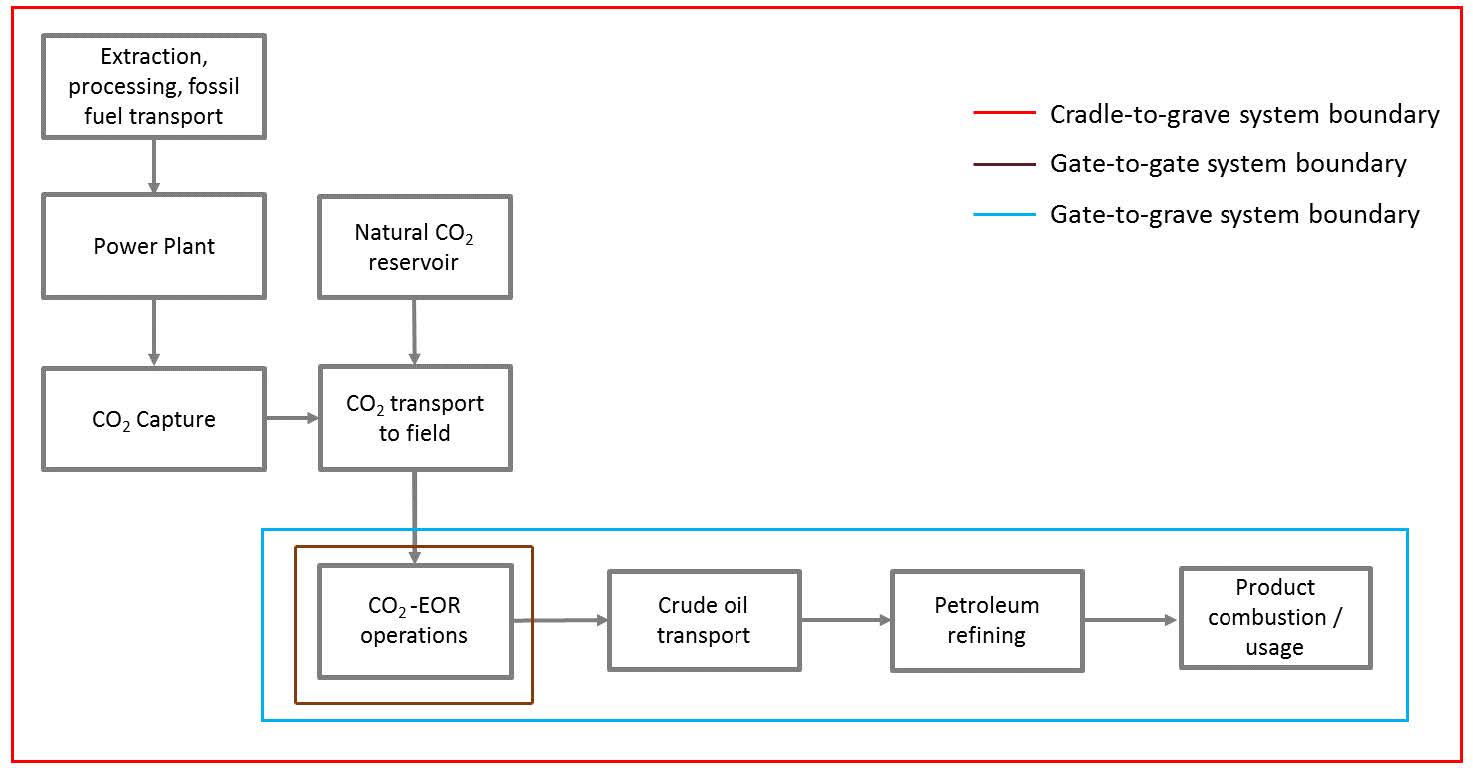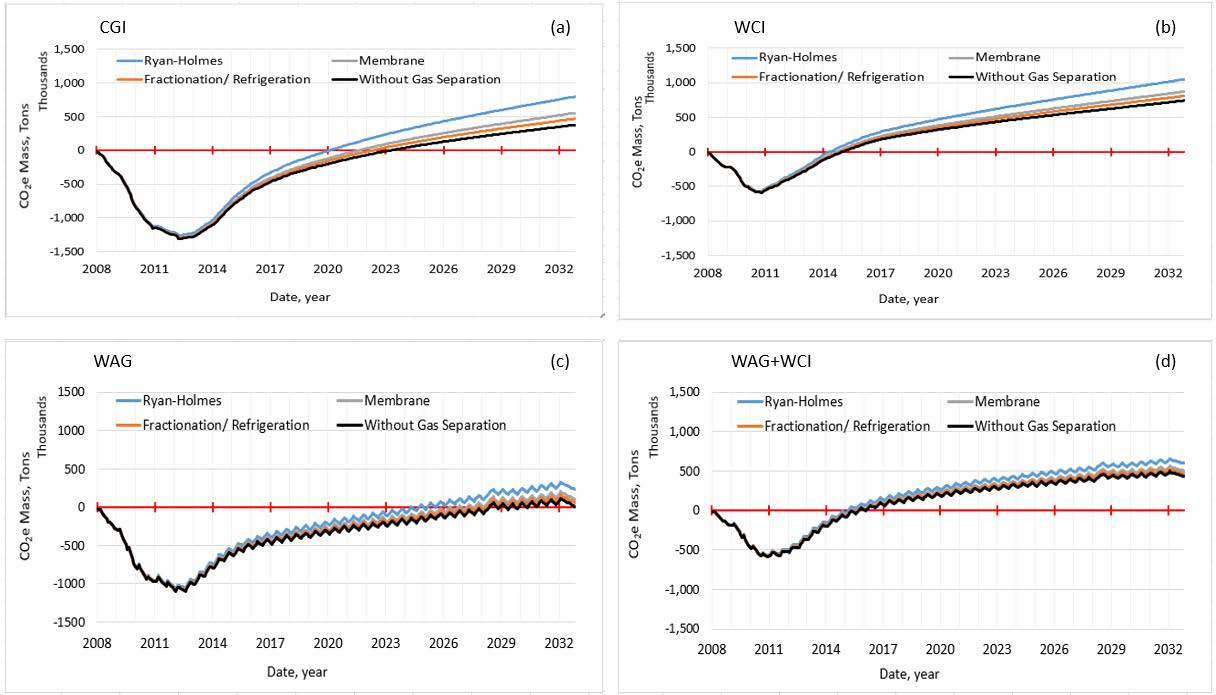Carbon Life Cycle Analysis of CO2-EOR for Net Carbon Negative Oil (NCNO) Classification
Principal Investigator: Vanessa Nuñez-López
Download the final report here.
Can a tertiary oil recovery, CO2-EOR, be operationally designed to both enhance oil production and reduce greenhouse gas emissions to the atmosphere?
Carbon dioxide enhanced oil recovery (CO2-EOR) is a technology most commonly applied in the third and final stage of development of mature oil fields to enhance oil production. The main goal of this study was to determine whether oil produced in a conventional CO2-EOR operation can be classified as net carbon negative oil (NCNO), as defined by the U.S. Department of Energy. Some have questioned the validity of CO2-EOR as an alternative for greenhouse gas emission reduction, as CO2 emissions result from the energy consumption throughout the EOR operation and, more significantly, from the combustion of the incremental oil produced.
To answer the question of how much carbon is emitted in CO2-EOR projects, a lifecycle analysis (LCA) has to be conducted. A LCA is a process that assesses the environmental impact resulting throughout a product’s lifecycle, from raw materials acquisition through production, use, final treatment, recycle, and disposal. This study found that both can be in balance.

The different boundaries used to assess an enhanced oil recovery operation's net carbon balance
Why this lifecycle analysis is different
This study classified the EOR product, crude oil, and assessed three system boundaries: gate-to-gate, gate-to-grave, and cradle-to-grave. This lifecycle was dynamic (d-LCA), linking instant energy demand and associated greenhouse gas emissions to instant operational performance in order to better understand the evolution of the environmental impact (emissions) and mitigation (storage). The study appreciated the unique challenges that each EOR field presents and, therefore, included various CO2 injection strategies. This model was coupled with a subsurface model that predicts reservoir response to capture the subsurface and surface emissions.
The reservoir and its carbon storage is a major cut to emissions
A CO2-EOR operator’s decisions have a major impact on associated geologic carbon storage volumes, which in turn affect the net carbon balance. In fact, carbon storage is the only parameter in the equation that counters the emissions. The subsurface geology is the biggest factor in determining which operational injection strategy is chosen (WAG, CGI, WCI, WAG + WCI defined below) and how much carbon can be stored. This is the biggest factor to optimize when the aim is to decrease the impact of oil production. Many previous LCA studies do not take operational strategies into account.
All CO2 operations start carbon negative
By injecting CO2 into the oil reservoir, some is left behind trapped in the rock. At the beginning of the operation, more CO2 is needed to start oil production by pushing the oil out. Four field development injection strategies were evaluated—water-alternating-gas (WAG), continuous gas injection (CGI), water curtain injection (WCI), and hybrid water-alternating-gas and water curtain injection (WAG + WCI)—and results showed that all start with a negative carbon footprint and, years later, transition to operating with a positive carbon footprint. Prolonging the carbon negative part of the operation can be a key climate change mitigation strategy.
Taking all of this into account, this study served as confirmation that CO2-EOR can be operationally designed to both enhance oil production and reduce greenhouse gas emissions to the atmosphere.

Example of the CO2 emissions over a project's lifecycle over 25 years. All operations start carbon negative when the carbon is stored into the oil reservoir and then over time more CO2 is needed to push the oil out and the process becomes carbon positive, releasing more atmospheric emissions than it stores.
Other results
Other results were a summary of the reservoir mass accounting and the monitoring, verification, and accounting (MVA) methodology with the opportunity to standardize the inputs into the lifecycle analysis. The study’s preferred mass accounting method differs from previous methodologies in that it follows purchased CO2 as the key mass accounting parameter—instead of total injected CO2—in order to avoid the accounting of recycle gas, as it introduces significant complexities which lead to significant mass accounting errors. Researchers’ present a MVA methodology referred to as Assessment of Low Probability Material Impacts (ALPMI). The researchers also made recommendations on EOR field activities that are conducive to producing NCNO.
Download the full report here.
Watch principal investigator, Vanessa Nuñez-López, give a talk about this NCNO project.
Publications
Núñez-López, Vanessa; Gil-Egui, Ramón; Hosseini, Seyyed A. Environmental and Operational Performance of CO2-EOR as a CCUS Technology: A Cranfield Example with Dynamic LCA Considerations. Energies 2019, 12, 448. https://doi.org/10.3390/en12030448.
Núñez-López, Vanessa, and Moskal, Emily. 2019. Potential of CO2-EOR for Near-Term Decarbonization. Frontiers in Climate 1 (September). https://doi.org/10.3389/fclim.2019.00005.
Gil-Egui, Ramón and Nuñez-Lopez, Vanessa. 2018. A Sustainable Approach to Decision-Making in CCUS Systems (October 24, 2018). 14th International Conference on Greenhouse Gas Control Technologies, GHGT-14 21st-25th October 2018, Melbourne, Australia. http://dx.doi.org/10.2139/ssrn.3380459.
Hosseininoosheri, Pooneh and Hosseini, Seyyed Abolfazl and Nuñez-Lopez, Vanessa and Lake, Larry. 2018. A Comparative Study of CO2-Flood Displacement Efficiency for Different CO2 Injection Strategies: Permian Basin vs. U.S. Gulf Coast. 14th Greenhouse Gas Control Technologies Conference Melbourne 21-26 October 2018 (GHGT-14). https://ssrn.com/abstract=3366350.
Nuñez-López, Vanessa and Gil-Egui, Ramón and Hosseini, Seyyed. 2018. CO2-EOR and GCS Co-Optimization with Carbon Lifecycle Analysis Considerations. 14th Greenhouse Gas Control Technologies Conference Melbourne 21-26 October 2018 (GHGT-14). http://dx.doi.org/10.2139/ssrn.3366074.
Hosseininoosheri, Pooneh, Hosseini, Seyyed A., Nuñez-López, Vanessa and Lake, Larry W. 2018. Impact of field development strategies on CO2 trapping mechanisms in a CO2–EOR field: A case study in the Permian Basin (SACROC unit). International Journal of Greenhouse Gas Control, Volume 72, Pages 92-104. https://doi.org/10.1016/j.ijggc.2018.03.002.
Hosseininoosheri, Pooneh, Hosseini, Seyyed A., Nuñez-López, Vanessa, & Lake, Larry W. (2018, April 22). Evolution of CO2 Utilization Ratio and CO2 Storage under Different CO2-EOR Operating Strategies: A Case Study on SACROC Unit Permian Basin. Society of Petroleum Engineers. https://doi.org/10.2118/190038-MS.
This study is funded and managed by the U.S. DOE/NETL, under award number DE-FE0024433.
Last Updated: July 9, 2020



